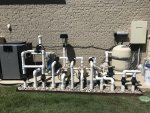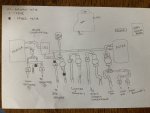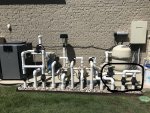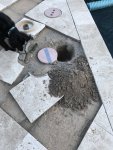Still having issues with a suction side leak, ....
Called Paramount about the air coming into my debris canister and Jim said he thinks there is cavitation caused by a blockage in the main drain leading to the canister. Tried a drain king device and can’t tell if the line is clear or not. The line from the canister to the pump is clear as far as I can tell.
I just found this post and have some info and maybe a temporary fix.
If you don't want to read to the end, I can tell you believe I have a leak in the fittings between the canister and the main drain which may be able to be sealed from the inside with pool putty.
I have a Paramount debris canister tied to both the main drain and the skimmer. I have had problems with air on and off for 15 years, Sometimes the air is so bad that it will drain the canister in a few minutes, making the pool unusable. Other times it seems ok. I have heard the cavitation theory and the blocked main drain theory. The drain is not blocked and I find it totally incredulous that the pump can continually pull several gallons of air out of the water in a matter of seconds. There's just not that much dissolved air in the volume of water on the suction side.
Some other variables I noticed were:
1) With the skimmer wide open, the problem is less. Gradually closing the skimmer gradually increases the problem.
2) When the pool is filled to the top of the skimmer, the problem is less. The lower the water, the more likely the problem will increase.
3) When it has rained significantly, the problem is less.
The pool builder, now out of business and pool service companies were of no help so I was left on my own to try and trouble shoot it.
I got a leak detection dye kit, opened up the debris canister and noticed a significant flow towards the main drain. I felt around the inside of the opening and could feel that there was a connector pipe between the canister fitting and main drain that had a smaller diameter.
On a hunch I got some pool putty and filled in that area. I again tested for a leak and it looked good. I started the pool back up and the air problem stopped - sorta. The problem is, the pool putty doesn't stick to the pipe that well and there is tremendous water pressure coming from the drain. It pulled the patch part-way off and dragged some putty onto the threaded opening of the canister. I again puttied the area, waiting 24 hours before starting the pump. This time the problem was completely gone. Even with the skimmer fully closed there was ZERO air in the canister. That lasted only a week. I noticed air again in the canister. I opened it up and saw bits of putty in the leaf basket. I felt around the connection and the putty had significantly pulled away from the pipe. So now I need to figure out how to get the putty to stay in place. Maybe wait 48 hours instead of 24. Eventually it will have to be dug up and fixed/replaced, but I can't get pool repair companies to return my calls or emails, even the ones specializing in skimmer replacements.
I believe all the variables I listed above are consistent with the fitting problem. First, with the amount of air coming in, there has to be a source close to the surface. It can't be an endless pocket of air under the bottom of the pool. Second, with the skimmer closed, a lot more pressure is put on the main drain fitting which opens up that fitting even more. Third, the lower water level, the more water is pulled from the main drain so more pressure on that joint again. And lastly, if the ground is saturated from rain, the source of air is likely cut off.
Anyway if anyone else has this problem I hope this helps because the pool companies won't.








